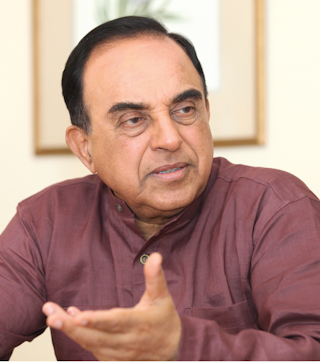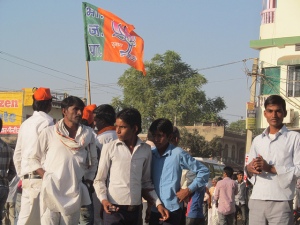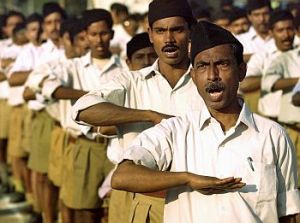
No university in this country can afford to have a hatemonger as its vice-chancellor who is best known for spewing venom and stoking rumours. (Image: Wikipedia)
In an article titled “The RSS game plan” published in Frontline magazine (Volume 17 – Issue 02, Jan 22 – Feb 04, 2000) a Harvard-educated economist wrote, “Today the creeping fascism of the Rashtriya Swayamsevak Sangh (RSS) is coming upon us.” He mentioned that the RSS leaders were frustrated at the fact that “symbolically, the bhagwa dhwaj (saffron double triangle flag) does not yet flutter from the Red Fort; but the hated tricolour which no RSS office can hoist even on August 15, still does.”
He accused the RSS of conniving to convert India into a Hindu Rashtra and stated that the saffron organisation had also prepared a rough draft on the lines of which the new Indian Constitution would be framed. He wrote that as per this draft, “The present bicameral Parliament would be replaced by a three-tier structure. At the apex will be a Guru Sabha of sadhus and sanyasis (read the VHP activists)…. All legislation and money bills will have to originate in the Guru Sabha and be passed by it before being sent to the Lok Sabha. The Guru Sabha will also be the judicial commission to nominate the Supreme Court judges, and impeach them.”
He mentioned that “Christians are being targeted by the front organisations of the RSS in order to terrorise and ghetto-ise all minorities” and that Hindutva justice meant “minorities can best look forward to liberation through mercy killing.” Who was the author of this piece? The answer (much to the surprise of many Hindutva maniacs) is Dr Subramanian Swamy!
Hindutva heart-throb, 2G scam whistle-blower and modern India’s biggest conspiracy theorist Dr Subramanian Swamy has a political history worth reading. Not only did Dr Swamy oppose the Emergency imposed in 1975 by Indira Gandhi-led Congress party, he was also responsible for bringing down Atal Bihari Vajpayee’s Bharatiya Janata Party government in 1999. As is visible from the extracts of the article Dr Swamy wrote several years back for Frontline magazine, he did not have much admiration for the kind of politics which was being played by the Sangh Parivar. In fact it appears that Dr Swamy detested Hindutva’s hate politics.
But things have changed now. After having spent many years in a state of political oblivion, Dr Swamy returned to the fore of Indian politics by blowing the lid off the 2G spectrum scam and advocating an extreme form of Hindutva. In the lead up to the 2014 General Elections, Dr Swamy officially merged his Janata Party with the BJP and formally became part of the Sangh Parivar.
This is nothing but a clear case of political opportunism. A person who vociferously criticised Hindutva politics in the past now happens to be one of its biggest advocates. News reports have suggested that Dr Subramanian Swamy has been offered the position of vice-chancellor of Jawaharlal Nehru University by the Union HRD ministry. People supporting his candidature might claim that he is a suitable candidate for the job as he possesses a PhD from the prestigious Harvard University and also attended the Hindu College at the Delhi University and Indian Statistical Institute in Kolkata while pursuing graduation and post graduation, respectively.
As far as his administrative accomplishments are concerned, Swamy is a five-time member of Parliament and has served as the Union law minister. He surely isn’t like Gajendra Chauhan who has been accused of being under qualified for the chairmanship of Film & Television Institute of India in Pune. Dr Swamy is a well-educated individual having substantial administrative experience but he certainly isn’t the right man to lead a university like JNU.
No university in this country can afford to have a hatemonger as its vice-chancellor who is best known for spewing venom and stoking rumours. Let us not forget that Dr Subramanian Swamy was expelled from Harvard University on account of his extremist views which became public following the publication of a bizarre article. Shortly after a terrorist attack in Mumbai on July 13, 2011, Dr Swamy wrote an article in DNA newspaper titled “How to wipe out Islamic terror” (July 16, 2011). This article became the reason behind the booting out of Dr Swamy from Harvard.
Dr Swamy who had earlier lambasted the RSS for aspiring to turn India into a Hindu Rashtra wrote, “Declare India a Hindu Rashtra in which non-Hindus can vote only if they proudly acknowledge that their ancestors were Hindus. Rename India Hindustan as a nation of Hindus and those whose ancestors were Hindus.” Does such a man deserve to be the vice-chancellor of a central university? In fact does he even deserve to be in public life? The founding fathers of the Indian Constitution rejected the notion of a Hindu Rashtra and established India as a secular state. They granted every Indian citizen universal adult suffrage.
But Dr Swamy does not agree with us. His contempt for the Constitution is visible from his own writings as he wants India to be converted into a Hindu Rashtra wherein non-Hindus will lose their right to vote and be elected as public representatives if they do not acknowledge their Hindu ancestry. Other unconstitutional suggestions of Dr Swamy included enacting “a national law prohibiting conversion from Hinduism to any other religion. Re-conversion (to Hinduism) will not be banned.” He also wanted to “remove the masjid in Kashi Vishwanath temple and the 300 masjids at other temple sites.”
That’s the kind of India that Dr Swamy envisions. Dreadful, isn’t it? A person who does not acknowledge India’s secular character and vouches for the creation of a Hindu Rashtra wherein Hindus and non-Hindus will not be equal citizens should never have been considered for any high office leave alone the office of the vice-chancellor of Jawaharlal Nehru University.
The students of JNU can never be expected to respect a person like Dr Swamy who has turned himself into a butt of jokes owing to his conspiracy theories which somehow tend to hint at the Hindu origins of every great innovation or invention that the world has witnessed. Dr Swamy belongs to that rare variety of political hypocrites who sometimes simultaneously espouse Hindutva chauvinism and minority politics. On one hand he stated, “If half the Hindus voted together, rising above caste and language, a genuine Hindu party would have a two-thirds majority in Parliament and the Assemblies” but he did not miss out on an opportunity to play the minority card while accusing the Congress of opposing Purno Sangma’s presidential candidacy in 2012 simply because he was a “Christian” and “tribal.”
There can be no defence for Dr Swamy’s irrational antics. Even Union HRD minister Smriti Irani cannot come out to justify Dr Swamy’s conception of India which is fascist, racist and discriminatory. Nor can she standby even one of Dr Swamy’s ridiculous conspiracy theories pertaining to the murder of Sanjay, Indira or Rajiv Gandhi. But then she might just do it as one does not expect much from an education, minister who stands accused of having lied about her own educational qualification.
The FTII row has failed to teach Modi sarkar a lesson. If there is even an iota of truth concerning Dr Swamy’s appointment as JNU VC then the BJP government should get prepared for a vicious backlash from academics and students who will not allow the communalisation of the country’s universities at the hands of individuals like Dr Swamy.
(This article was originally published in DailyO.)



